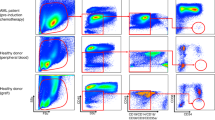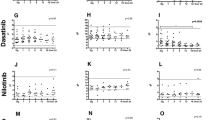Abstract
Polyclonal antithymocyte globulins (ATGs) are used in organ and allogeneic stem cell transplantation mainly due to their immunomodulatory potential. Since ATGs contain antibodies against antigens expressed on various hematopoetic cells, it is not surprising that they induce cell death not only in healthy T-, B-, NK, and dendritic cells but also in malignant cells of lymphatic and to a lesser extent of myeloid lineage. The cytotoxic and antiproliferative effects of ATGs in malignant B-cells have been known for many years, without attracting clinical attention due to the advent of monoclonal antibodies like rituximab. Recent data indicate a potential role of ATGs in the therapy of multiple myeloma, a disease in which monoclonal serotherapy has been rather unsuccessful. This review discusses available data demonstrating the cytotoxic effects of ATGs and envisages a possible new role of these polyclonal antibodies in the therapy of hematological malignancies.
Similar content being viewed by others
References
Zander AR, Zabelina T, Kröger N et al (1999) Use of a five-agent GvHD prevention regimen in recipients of unrelated donor marrow. Bone Marrow Transplant 23:889–893
Finke J, Bertz H, Schmoor C et al (2000) Allogeneic bone marrow transplantation from unrelated donors using in vivo anti-T cell globulin. Br J Haematol 111:303–313
Remberger M, Svahn B-M, Hentschke P et al (1991) Effect on cytokine release and graft-versus-host disease of different anti-T cell antibodies during conditioning for unrelated haematopoietic stem cell transplantation. Bone Marrow Transplant 24:823–830
Bacigalupo A, Lamparelli T, Bruzzi P et al (2001) Antithymocyte globulin for graft-versus-host disease prophylaxes in transplants form unrelated donor: 2 randomized studies from Gruppo Italiono Trapianti Midollo Osseo (GITMO). Blood 98:2942–2947
Meijer E, Cornelissen JJ, Lowenberg B, Verdonck LF (2003) Antithymocyteglobulin as prophylaxis of graft-versus-host disease in recipients of partially depleted grafts from matched unrelated donors: a dose finding study. Exp Hematol 31:1026–1030
Kalwak K, Moson I, Cwian J et al (2003) A prospective analysis of immune recovery in children following allogeneic transplantation of t-cell-depleted or non-T-cell-depleted hematopoietic cells from HLA-disparate family donors. Transplant Proc 35:1551–1555
Meijer E, Bloem AC, Dekker AW, Verdonk LF (2003) Effect of antithymocyte globulin on quantitative immune recovery and graft-versus-host disease after partially T-cell depleted bone marrow transplantation: a comparison of matched related and matched unrelated grafts. Transplantation 75:1910–1913
Fehse N, Fehse B, Kroger N et al (2003) Influence of anti-thymocyte globulin as part of the conditioning regimen on immune reconstitution following matched related bone marrow transplantation. J Hematother Stem Cell Res 12:237–242
Kröger N, Shaw B, Iacobelli S et al (2005) The Clinical Trial Committee of the British Society of Blood and Marrow Transplantation and the German Cooperative Transplant Group Comparison between antithymocyte globulin and alemtuzumab and the possible impact of KIR–ligand mismatch after dose-reduced conditioning and unrelated stem cell transplantation in patients with multiple myeloma. Br J Haematol 129(5):631–643
Ayuk F, Perez-Simon A, Shimoni A et al (2008) Clinical impact of human Jurkat T-cell-line-derived antithymocyte globulin in multiple myeloma patients undergoing allogeneic stem cell transplantation. Haematologica 93(9):1343–1350, Sep
Bonnefoy-Berard N, Genestier L, Flacher M et al (1994) Apoptosis induced by polyclonal antilymphocyte globulins in human B-cell lines. Blood 83:1051–1059
Zand MS, Vo T, Huggins J et al (2005) Polyclonal rabbit antithymocyte globulin triggers B-cell apoptosis by multiple pathways. Transplantation 79:1507–1515
Ayuk F, Fang L, Fehse B et al (2005) Antithymocyte globulin induces complement-dependent cell lysis and caspase-dependent apoptosis in myeloma cells. Exp Hematol 33:1531–1536
Bonnefoy-Berard N, Revillard JP (1996) Mechanisms of immunosuppression induced by antithymocyte globulins and OKT3. J Heart Lung Transplant 15(5):435–442
Michallet MC, Preville X, Flacher M, Fournel S, Genestier L, Revillard JP (2003) Functional antibodies to leukocyte adhesion molecules in antithymocyte globulins. Transplantation 75:657–662
Bonnefoy-Berard N, Vincent C, Revillard JP (1991) Antibodies against functional leukocyte surface molecules in polyclonal antilymphocyte and antithymocyte globulins. Transplantation 51:669–673
Raefsky EL, Gascon P, Gratwohl A, Speck B, Young NS (1986) Biological and immunological characterization of ATG and ALG. Blood 68:712–719
Rebellato LM, Gross U, Verbanac KM, Thomas JM (1994) A comprehensive definition of the major antibody specificities in polyclonal rabbit antithymocyte globulins. Transplantation 57:685–694
Preville X, Nicolas L, Flacher M, Revillard J (2000) A quantitative flow cytometry assay for the preclinical testing and pharmacological monitoring of rabbit antilymphocyte globulin (rATG). J Immunol Methods 245:45–54
Pistillo MP, Tazzari PL, Bonifazi F et al (2002) Detection of a novel specificity (CTLA-4) in ATG/TMG Globulins and sera from ATG-treated leukemic patients. Transplantation 73:1295–1302
Bourdage JS, Hamlin DM (1995) Comparative polyclonal antithymocyte globulin and antilymphocyte/antilymphoblast globulin anti-CD antigen analysis by flow cytometry. Transplantation 27:1194–1200
Bacigalupo A, Lamparelli T, Bruzzi P et al (2001) Antithymocyte globulin for graft-versus-host disease prophylaxes in transplants form unrelated donor: 2 randomized studies from Gruppo Italiono Trapianti Midollo Osseo (GITMO). Blood 98:2942–2947
Meijer E, Cornelissen JJ, Lowenberg B, Verdonck LF (2003) Antithymocyteglobulin as prophylaxis of graft-versus-host disease in recipients of partially depleted grafts from matched unrelated donors: a dose finding study. Exp Hematol 31:1026–1030
Duggan P, Booth K, Chaudhry A et al (2002) Alberta Blood and Bone Marrow Transplant Program. Unrelated donor BMT recipients given pretransplant low-dose antithymocyte globulin have outcomes equivalent to matched sibling BMT: a matched pair analysis. Bone Marrow Transplant 30:681–686
Schleuning M, Gunther W, Tischer J et al (2003) Dose-dependent effects of in vivo antithymocyte globulin during conditioning for allogeneic bone marrow transplantation from unrelated donors in patients with chronic phase CML. Bone Marrow Transplant 32:243–250
Zander AR, Zabelina T, Kröger N et al (1999) Use of a five-agent GvHD prevention regimen in recipients of unrelated donor marrow. Bone Marrow Transplant. 23:889–893
Eiermann TH, Lambrecht P, Zander AR (1999) Monitoring anti-thymocyte globulin (ATG) in bone marrow recipients. Bone Marrow Transplant 23:779–781
Yoshimi A, Ito M, Kojima S (2005) Leukemic cell death induced by antithymocyte globulin. Leuk Res 29:821–827
Bonnefoy-Berard N, Flacher M, Revillard JP (1992) Antiproliferative effect of antilymphocyte globulins on B cells and B-cell lines. Blood 79(8):2164–2170, Apr 15
Ayuk F, Atassi N, Schuch G et al (2008) Complement-dependent and complement-independent cytotoxicity of polyclonal antithymocyte globulins in chronic lymphocytic leukemia. Leuk Res. 32(8):1200–1206, Aug
Singal R, Winfield DA, Greaves M (1991) Bone marrow aplasia in B cell chronic lymphocytic leukaemia: successful treatment with antithymocyte globulin. J Clin Pathol 44:954–956
Radosevich CA, Gordon LI, Weil SC, Marder RJ, Rosen ST (1988) Complete resolution of pure red cell aplasia in a patient with chronic lymphocytic leukemia following antithymocyte globulin therapy. JAMA 5:723–725
Lowsky R, Takahashi T, Liu YP et al (2005) Protective conditioning for acute graft-versus-host disease. N Engl J Med 353(13):1321–1331
Zand MS, Vo T, Pellogrin T et al (2006) Apoptosis and complement-mediated lysis of myeloma cells by polyclonal rabbit antithymocyte globulin. Blood 107:2895–2903
Timm MM, Kimlinger TK, Haug JL et al (2006) Thymoglobulin targets multiple plasma cell antigens and has in vitro and in vivo activity in multiple myeloma. Leukemia 20:1863–1869
Kröger N, Perez-Simon JA, Myint H et al (2004) Relapse to prior autograft and chronic graft-versus-host disease are the strongest prognostic factors for outcome of melphalan/fludarabine-based dose-reduced allogeneic stem cell transplantation in patients with multiple myeloma. Biol Blood Marrow Transplant 10:698–708
Perez-Simon JA, Martino R, Alegre A et al (2003) Chronic but not acute graft-versus-host disease improves outcome in multiple myeloma patients after non-myeloablative allogeneic transplantation. Br J Hematol 121:104–108
Treon SP, Pilarski LM, Belch AR et al (2002) CD20-directed serotherapy in patients with multiple myeloma: biological considerations and the therapeutic applications. J Immunother 25:72–81
Tai YT, Catley LP, Mitsiades CS et al (2004) Mechanisms by which SGN-40, a humanized anti-CD40 antibody induces cytotoxicity in human multiple myeloma cells: clinical implications. Cancer Res 64:2846–2852
Matsui W, Huff CA, Wang Q et al (2004) Characterization of clonogenic multiple myeloma cells. Blood 103:2332–2336
Author information
Authors and Affiliations
Corresponding author
Rights and permissions
About this article
Cite this article
Ayuk, F., Zander, A. & Kröger, N. Antitumor effects of polyclonal antithymocyte globulins: focus on B-cell malignancies and multiple myeloma. Ann Hematol 88, 401–404 (2009). https://doi.org/10.1007/s00277-009-0696-8
Received:
Accepted:
Published:
Issue Date:
DOI: https://doi.org/10.1007/s00277-009-0696-8




